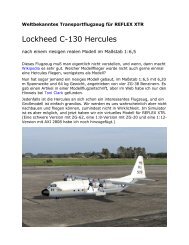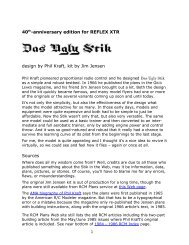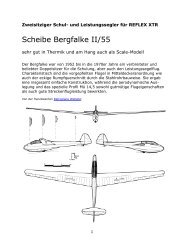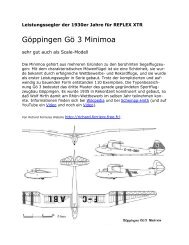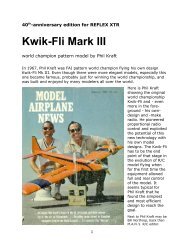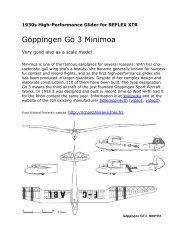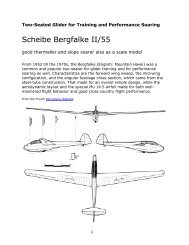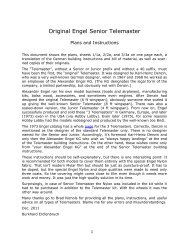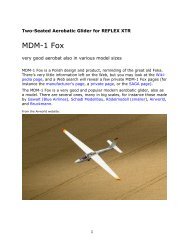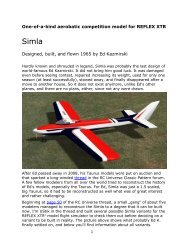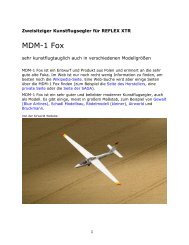Boelkow Bo 208 / M.F.I. MFI-9 "Junior" for REFLEX XTR
Boelkow Bo 208 / M.F.I. MFI-9 "Junior" for REFLEX XTR
Boelkow Bo 208 / M.F.I. MFI-9 "Junior" for REFLEX XTR
You also want an ePaper? Increase the reach of your titles
YUMPU automatically turns print PDFs into web optimized ePapers that Google loves.
Sports airplane scale model <strong>for</strong> <strong>REFLEX</strong> <strong>XTR</strong><br />
Bölkow <strong>Bo</strong> <strong>208</strong> / M.F.I. <strong>MFI</strong>-9 “Junior”<br />
Small and simple, but powerful and versatile<br />
It’s a » square tin box that has been taught to fly «, as well-known aviation<br />
author Richard Bach wrote in his review (nice reading), and it’s even a rather<br />
small box, but you would be surprised at how well it learnt to fly.<br />
The Junior is actually an amateur-build design, even if Björn Andreasson, its<br />
designer, was a professional. Obviously, he had a talent to find simple but<br />
effective solutions. He enhanced his original design after the test flights, and<br />
later Bölkow in Germany got a license and built 210 of them.<br />
This picture is borrowed from www.HB-UPC.ch (un<strong>for</strong>tunately, the website<br />
vanished) and shows this nicely restored Swiss-registered Junior (supposedly<br />
with the happy restorer in the pilot’s seat). Look how small this two-seater is<br />
after all!<br />
1
Sports airplane scale model <strong>for</strong> <strong>REFLEX</strong> <strong>XTR</strong><br />
<strong>Bo</strong> <strong>208</strong> / <strong>MFI</strong>-9 “Junior”<br />
Look at the big propeller spun by a 100 hp engine and at the quite thin wing<br />
airfoil in the picture above, and you’ll know that this is a fast flying airplane.<br />
Look at the cambered airfoil and the big flaps in the plan below, and you’ll<br />
also know that this airplane is as well able to fly slowly and land shortly. You<br />
might even imagine that it is able to do basic aerobatics, even if positive-g<br />
only due to the wing struts. These abilities will all show on a scale model.<br />
Some unique features of the original are not relevant <strong>for</strong> a model. The <strong>for</strong>ward<br />
swept wing is even beveled to the canopy and is on eye-level so the<br />
pilot has full visibility above and below the wing. The full-flying horizontal<br />
stabilizer has an additional anti-servo tab to give the pilot some stick <strong>for</strong>ce<br />
and feeling. The rudder is thickened at the trailing edge <strong>for</strong> better effect<br />
(what even makes <strong>for</strong> some whistling noise in flight). These features are built<br />
into a model only to make it true-to-scale.<br />
2
Sports airplane scale model <strong>for</strong> <strong>REFLEX</strong> <strong>XTR</strong><br />
<strong>Bo</strong> <strong>208</strong> / <strong>MFI</strong>-9 “Junior”<br />
Other features just have to be copied in the model. Especially functional wing<br />
struts are needed because the wings are too thin to be strong enough with<br />
only the spars.<br />
Anyway, you may expect an interesting scale model, at least due to the<br />
unique look of the Junior. But besides its look, its talents as a glider tug are<br />
amazing. Equally scaled as the glider, it’s quite small and inexpensive. It’s<br />
able to tow lightweight slow gliders and heavy fast gliders as well. It climbs<br />
and descends quickly and needs only the towline’s length <strong>for</strong> landing. And<br />
you may just have fun knocking it around and flying simple aerobatics. And<br />
you may have most of all that– just except the tow itself – in <strong>REFLEX</strong>.<br />
Sources<br />
There’s the comprehensive website www.<strong><strong>Bo</strong>elkow</strong>-Junior.de where all<br />
available reviews and articles are collected and presented, most of them in<br />
English. Nearly all in<strong>for</strong>mation I have about the Junior is from there.<br />
The website www.HB-UPC.ch (no longer available) had not only pictures but<br />
also manuals (in German) of the original aircraft (C version).<br />
Contributions<br />
Herbert and Janning Quint recorded the sound of a well-muffled Zenoah ZG<br />
38 gas engine and published it on RC-Sim.de. This sound is assigned to the<br />
bigger model versions.<br />
Rich Noon reviewed the Zenoah G20ei gas engine with the stock muffler <strong>for</strong><br />
RC Groups and provided a video from which the sound was extracted. This<br />
sound is assigned to the smaller model versions.<br />
Shape and Appearance<br />
Though the <strong>REFLEX</strong> model is painted like the Swiss Junior in the picture<br />
above, it is not shaped after this aircraft and the drawing above. Instead I<br />
used the drawings from an Air Progress magazine article presented on the<br />
website www.<strong><strong>Bo</strong>elkow</strong>-Junior.de. During production time the aircraft was<br />
modified several times. There are three main versions named A, B, and C,<br />
and sub-versions to each of them.<br />
The drawing above might show the B version. Bölkow later extended the<br />
wing tips to have more wing area. As shown here, they widened the fuselage<br />
and set the main bulkhead a bit further back to have a roomier cabin. The<br />
drawings below supposedly show the Bölkow A version as well as the original<br />
Swedish Junior and the military trainer version built by M.F.I. (Malmö Flyg<br />
Industri, later SAAB) as <strong>MFI</strong>-9 (which became famous in the Biafra civil war).<br />
3
Sports airplane scale model <strong>for</strong> <strong>REFLEX</strong> <strong>XTR</strong><br />
<strong>Bo</strong> <strong>208</strong> / <strong>MFI</strong>-9 “Junior”<br />
4
Sports airplane scale model <strong>for</strong> <strong>REFLEX</strong> <strong>XTR</strong><br />
<strong>Bo</strong> <strong>208</strong> / <strong>MFI</strong>-9 “Junior”<br />
5
Sports airplane scale model <strong>for</strong> <strong>REFLEX</strong> <strong>XTR</strong><br />
<strong>Bo</strong> <strong>208</strong> / <strong>MFI</strong>-9 “Junior”<br />
The airplane’s controls – including the flaps – are so simple that there’s no<br />
problem to render them correctly on a model. The same is true <strong>for</strong> the<br />
landing gear. By the way, it’s not possible to correctly render the ski landing<br />
gear in <strong>REFLEX</strong>. The floats may be rendered correctly but they are not<br />
working correctly because no floating and planing effects are simulated.<br />
Finally, there’s no tow release and no glider tow at all in <strong>REFLEX</strong> (so far).<br />
All main parts of the aircraft have only simple curvature because they are<br />
made from simply bent sheet metal. More complicated are only the wing and<br />
empennage tips and the engine cowl front. They are made from fiberglass in<br />
the original and could be also in a model, but carved blocks of light balsa<br />
would do fine as well.<br />
The B and C versions are more complicated in several details and that’s why<br />
I preferred to render the A version in <strong>REFLEX</strong>. Especially details on the model<br />
and in its cabin are made after pictures found on www.<strong><strong>Bo</strong>elkow</strong>-Junior.de.<br />
Painting was done following the pictures on www.HB-UPC.ch, but not strictly.<br />
I used (had only) different fonts <strong>for</strong> the registration on wing and fuselage<br />
and <strong>for</strong> the type name on the engine cowl. The Bölkow logo is correct since it<br />
was copied from one of the original manuals downloaded from the website.<br />
A photo of the aircraft’s instrument panel was usable <strong>for</strong> a better scale look.<br />
The lower part is not rendered but you won’t see it, anyway. The Y-shaped<br />
yoke is shown in <strong>REFLEX</strong> as well as some seat upholstery. Later, a pilot was<br />
borrowed from <strong>REFLEX</strong> (the Grunau Baby), but the floats and skis versions<br />
have no pilot because it would exceed a <strong>REFLEX</strong> limit (number of points).<br />
By the way, when running the simulation look into the cabin and watch the<br />
yoke while moving the elevator stick on your transmitter (a gadget).<br />
6
Sports airplane scale model <strong>for</strong> <strong>REFLEX</strong> <strong>XTR</strong><br />
<strong>Bo</strong> <strong>208</strong> / <strong>MFI</strong>-9 “Junior”<br />
The model’s propeller is a wooden Master Airscrew, mainly because I had it,<br />
but also because a wooden propeller is well suited to the gas engines used.<br />
The original aircraft has grey or black colored metal propellers. The spinner is<br />
aluminum colored just because I like that more than a yellow one.<br />
The exhaust pipes shown are those of the original. The gas engines used in<br />
the model would have different exhausts, but it would be excessive to render<br />
all the different model engine exhausts of the different versions.<br />
The drawings show important values, which are used not only to shape the<br />
model in <strong>REFLEX</strong> but also to set the parameters. These are wing dihedral and<br />
incidence (both 1 degree), wing sweep (-3 degrees), and propeller right and<br />
down thrust (1.5 and 4 degrees).<br />
7
Sports airplane scale model <strong>for</strong> <strong>REFLEX</strong> <strong>XTR</strong><br />
<strong>Bo</strong> <strong>208</strong> / <strong>MFI</strong>-9 “Junior”<br />
Setup<br />
As usual, I took the geometry from the drawing and put it into Blaine Beron-<br />
Rawdon’s excellent Plane Geometry spreadsheets (see the overview on his<br />
website) to get most of the physical parameters. The airfoil and wing coefficients<br />
were calculated in an own spreadsheet. All calculated values and the<br />
values from the drawing were simply transferred to <strong>REFLEX</strong>. The model<br />
worked right away, so no tweaking or fudging was done.<br />
The airfoil coefficients had to be estimated. The original has a NACA 23008.5<br />
airfoil, which means 8.5% thickness, 1.9% camber, and a rather <strong>for</strong>ward<br />
point of maximum camber (16.6% of chord length). This airfoil was chosen<br />
<strong>for</strong> its thinness to get a fast flying plane. The <strong>for</strong>ward camber was chosen to<br />
have airfoil moments counteracting the effects of the low center of gravity<br />
and make do with a small tail. The same reasons hold <strong>for</strong> a model so the<br />
same airfoil could be used, particularly because it translates well into the<br />
small model Reynolds numbers.<br />
Un<strong>for</strong>tunately, there are no measurements available, least of all low-Re<br />
measurements. Fortunately, the JavaFoil program by Martin Hepperle is able<br />
to approximate the airfoil coefficients, at least if the Eppler algorithms <strong>for</strong><br />
boundary layer and stall are used. It turns out that a HQ airfoil (by Helmut<br />
Quabeck) of similar thickness and camber may be used as well. And by the<br />
way, the <strong>for</strong>ward camber of the NACA airfoil gives the drooping wing leading<br />
edge you may see in the drawing and maybe on the <strong>REFLEX</strong> model, too.<br />
The center-of-gravity (C/G) was set by calculation and trial. In the Plane<br />
Geometry spreadsheets, about 12% static margin was chosen because that<br />
proved to give a pleasant balance <strong>for</strong> level flight with 50% to 70% power.<br />
It's in the original's weight-and-balance envelope as well so the model is<br />
really true-to-scale. For full-power flight, simply trim a bit down elevator,<br />
like in a real aircraft. The model is then almost neutrally stable.<br />
Control deflections were set in a pragmatic manner. Rudder deflection is set<br />
to 30 degrees just because that’s customary. The all-flying elevator has only<br />
8 degrees deflection to avoid unstable flying conditions (though the rudder<br />
bevel allows <strong>for</strong> 15 degrees). 30 degrees, a nice round number, was set <strong>for</strong><br />
the ailerons, together with 20% differential. No exponential rate was set.<br />
Maximum flap deflection is 30 degrees to have a decent climb with flaps fully<br />
deployed (the original has 35 degrees). All these settings turned out to be<br />
adequate <strong>for</strong> normal and safe flying.<br />
There is very little adverse yaw left, at least with flaps retracted. But there is<br />
still some rudder needed in some situations, at least it’s advisable. There<strong>for</strong>e<br />
you might just as well set smaller (10%) or no aileron differential and fly<br />
aileron-rudder coordinated, anyway. In this case, you should also remove<br />
propeller right thrust because that as well can be correct only in some situations<br />
and will be inconvenient in all others.<br />
8
Sports airplane scale model <strong>for</strong> <strong>REFLEX</strong> <strong>XTR</strong><br />
<strong>Bo</strong> <strong>208</strong> / <strong>MFI</strong>-9 “Junior”<br />
The <strong>REFLEX</strong> model was set up <strong>for</strong> three different scales and in each scale<br />
with three different drives. My favorite scale is 1:3 in which the model has<br />
2.48 m / 97.5” wingspan and a typical weight of 11 kg / 24 lb. Many modern<br />
“scale” glider models are scaled 1:3 and the Junior is a pleasantly small but<br />
powerful tug. An already more traditional scale <strong>for</strong> glider models is 1:3.5, in<br />
which the Junior model has only 2.12 m / 83.5” wingspan and 8 kg / 18 lb<br />
typical weight. This handy size is just neat! Only <strong>for</strong> comparison, the model<br />
is scaled also 1:2.5 with still only 2.97 m / 117” wingspan and 16 kg / 35 lb<br />
typical weight.<br />
For me, these weights are typical <strong>for</strong> the respective size of the model (not<br />
scale). They would allow building a real model not especially weight-saving<br />
and using the quite heavy (but cheap and reliable) magneto-ignition Zenoah<br />
gas engines. So these weights are not especially low and the aircraft is not a<br />
STOL one. But it has a quite big wing area (low aspect ratio) and a cambered<br />
airfoil to carry the weight. And it has (simple but) big flaps <strong>for</strong> low speed and<br />
short landings. It’s all quite well thought-out by the designer.<br />
A small tug means the engine has to haul less tug airframe and more power<br />
is left to haul the glider. So the smaller tug needs a smaller engine than a<br />
bigger one. Additionally, a tug should use a small-pitch propeller because<br />
high speed is not needed but big thrust, which is then obtained with an even<br />
smaller engine.<br />
It turns out that a ZG 45 is typical and sufficient <strong>for</strong> the 1:3 tug. The ZG 62<br />
is brute <strong>for</strong>ce <strong>for</strong> this small model as it gives a 1.1 thrust/weight ratio, but<br />
you may like it. If the model is used only <strong>for</strong> sports flying including basic<br />
aerobatics, even a ZG 26 is enough and will give nice scale-like flying. This is<br />
worth considering because this engine is cheap compared to the ZG 45 and<br />
ZG 62, which both need the Hydro Mount System by Toni Clark <strong>for</strong> vibration<br />
and noise reduction.<br />
The 1:3.5 model might do with the ZG 26 even <strong>for</strong> towing. A ZG 20 may be<br />
used <strong>for</strong> sports flying and a ZG 38 <strong>for</strong> very good towing per<strong>for</strong>mance. Cheap<br />
engine and cheap model <strong>for</strong> towing many if not most of today’s scale gliders<br />
– very interesting! Compare a 1:3.5 Wilga: 3.20 m / 126” wingspan, 16 kg /<br />
35 lb weight, ZG 80. The Junior is the right scale tug <strong>for</strong> the cheapskate.<br />
The 1:2.5 model will need the ZG 62 <strong>for</strong> towing and will well take a ZG 80 <strong>for</strong><br />
even better per<strong>for</strong>mance, but at substantially higher cost. It even needs the<br />
already quite expensive ZG 45 <strong>for</strong> sports flying and is there<strong>for</strong>e in a higher<br />
class than the smaller scale models. That would be a possibility <strong>for</strong> only few<br />
model tug pilots who in this case would probably prefer a “better” and “nicer”<br />
type of airplane, anyway.<br />
The propellers <strong>for</strong> the different versions were chosen as recommended by<br />
Toni Clark. For each drive the lowest-pitch propeller was chosen. Static<br />
thrust was specified on these web pages in some cases and in the other<br />
cases was estimated using ThrustHP Calculator. Maximum engine rpm and<br />
9
Sports airplane scale model <strong>for</strong> <strong>REFLEX</strong> <strong>XTR</strong><br />
<strong>Bo</strong> <strong>208</strong> / <strong>MFI</strong>-9 “Junior”<br />
propeller pitch were used to estimate the maximum flight speed. Engine<br />
torque was specified <strong>for</strong> all engines.<br />
The true-to-scale propeller diameters are 21” (1:3), 18” (1:3.5), and 25”<br />
(1:2.5), respectively. It turned out that in each scale the medium-sized<br />
engine (ZG 45, ZG 26, ZG 62, respectively) uses exactly this propeller<br />
diameter. For me, that is an indication to see these engines as the typical<br />
ones <strong>for</strong> the respective scale. That’s in addition to my feeling these engines<br />
are just right, even if you might prefer the bigger ones. But also consider<br />
that only the even smaller engines give a “scale-like” flying.<br />
Flight Characteristics<br />
The Bölkow Junior is a smooth and safe flying utility airplane.<br />
The model is balanced <strong>for</strong> take-off and climb, and <strong>for</strong> slow flight with only<br />
30% to 50% power. For cruise flight with 50% to 70% power simply trim a<br />
bit down elevator, like in a real aircraft, and even more at full power. The<br />
model is then pretty neutrally stable. With the standard trim and full power,<br />
it will climb at considerable speed and at a decent rate.<br />
This flight regime is used <strong>for</strong> towing fast and heavy gliders, <strong>for</strong> instance<br />
aerobatic gliders with their high wing loading and low-cambered wing airfoil.<br />
The Junior has an even higher wing loading but that is compensated by a<br />
slightly more cambered airfoil, so it’s a perfect match.<br />
Slow and lightweight gliders, <strong>for</strong> instance thermal gliders, are best towed<br />
with flaps 10 degrees down. These flaps are reaching to 70% of the wing<br />
span, and even though they are very simply shaped they have a huge effect.<br />
10 (original: 8) degrees deflection just substantially increases lift without<br />
noticeably increasing drag. So tug and glider are again perfectly matched.<br />
10 degrees flaps may also be used <strong>for</strong> short take-off and steep climb, if and<br />
when needed. But there is no normal landing and no landing at all (except<br />
emergency) without flaps. Even though the original has variable flap deflections<br />
up to 35 degrees, <strong>for</strong> the model I would prefer simply three positions:<br />
0, 10, and 30 degrees. More than 30 degrees is not needed but might be<br />
even dangerous. It would not give more lift but progressively more drag. The<br />
big flaps at 30 degrees and the big fuselage cross-section give well enough<br />
drag <strong>for</strong> a steep approach and short landing.<br />
You’d wonder how fast and long landings could be with less than 30 degrees<br />
flaps. The increased lift is just needed to compensate the rather high wing<br />
loading. But as always when using highly effective flaps, a bit practice is<br />
needed to make really good landings (which are even scored in glider tow<br />
competition). Learn to maintain a moderate pitch angle (attitude) during<br />
landing approach (the flaps make <strong>for</strong> a lower angle-of-attack). Pulling the<br />
model’s nose too high reduces speed only marginally but increases drag and<br />
there<strong>for</strong>e sink rate substantially. Once the model sags it’s nearly too late to<br />
10
Sports airplane scale model <strong>for</strong> <strong>REFLEX</strong> <strong>XTR</strong><br />
<strong>Bo</strong> <strong>208</strong> / <strong>MFI</strong>-9 “Junior”<br />
recover, and that’s possible only with more power (giving more speed) and<br />
not with more elevator, which would let the model just plop down hard.<br />
Junior landings are not hard; they are just different, due to both the big flaps<br />
and the all-flying horizontal stabilizer. If you are only used to a 5 ft wingspan<br />
and 6 lb weight pattern model you’ll have to practice. But after mastering the<br />
right technique, you will land the 8 ft / 24 lb Junior just as slow and short as<br />
the much smaller pattern plane. Can’t believe? View the demo flight! (Hit F9<br />
in <strong>REFLEX</strong>, select “<strong>Bo</strong> <strong>208</strong> Junior”.)<br />
There you’ll see some aerobatics, too. The basic maneuvers loop, roll, and<br />
stall turn may be flown just <strong>for</strong> fun, even if not in perfect shape. Inverted<br />
flight should be possible but no inverted maneuvers due to the wing struts<br />
(the original is rated <strong>for</strong> +4.4/-1.7 g load factor). Spins or even flick (snap)<br />
rolls are not possible because the Junior doesn’t really stall (both original and<br />
model). What you may notice at high angles-of-attack might be some directional<br />
instability caused by the <strong>for</strong>ward sweep, but I don’t know <strong>for</strong> sure.<br />
You may notice no real stall and a refusal to spin, though. That’s even trueto-reality<br />
since the airplane was certificated <strong>for</strong> spinning but only the factory<br />
test pilot managed to do it (see here at last page). Try his trick in <strong>REFLEX</strong> –<br />
it will even work! »The airplane will spin out of the second turn of a spiral<br />
dive upon application of full rudder and opposite aileron with stick full back.«<br />
Stunning! Only recovery is much simpler than in reality.<br />
For comparison, there’s an “expert” setup of the big version with the ZG 45<br />
(because it’s closest to the real thing), with 35 degrees flap deflection and 15<br />
degrees elevator. This setup spins without any trick and may be fully flared<br />
<strong>for</strong> landing. But you may notice that you really have to be an expert (or<br />
practise) to do this properly. The picture shows full flaps and full up elevator<br />
as well as the paint scheme used <strong>for</strong> the first airplanes built in the 1960s.<br />
11
Sports airplane scale model <strong>for</strong> <strong>REFLEX</strong> <strong>XTR</strong><br />
<strong>Bo</strong> <strong>208</strong> / <strong>MFI</strong>-9 “Junior”<br />
Glider Towing<br />
There’s one point left to discuss: Many of you won’t believe such a small and<br />
weak model could be a tug at all. But the Junior model would be a good tug<br />
even with the mid-size engines. How I know? That’s simple, just physics.<br />
Only <strong>for</strong> you incredulous there are now a few setups <strong>for</strong> <strong>REFLEX</strong> so you may<br />
try yourself and see. (The early original paint scheme is applied because the<br />
Junior was often used <strong>for</strong> glider towing in Germany. D-EGNA was the demonstrator<br />
brought to the USA and test-flown by Richard Bach and others <strong>for</strong><br />
their reviews and looked roughly like that.)<br />
And to <strong>for</strong>estall any objections here’s how the parameter setup was done:<br />
Let’s assume the 1:3.5 Junior with the ZG 26 engine has to tow an equally<br />
scaled MDM-1 Fox aerobatic glider. Junior’s wingspan is 2.12 m, that of the<br />
Fox is 4 m. Weights are 8 and 7 kg, respectively. The propeller has to haul<br />
both airplanes now and the thrust/weight ratio is 6.5/(8+7)=0.43 in contrast<br />
to 0.8 without the glider. The parasitic drag of both airplanes is added up, as<br />
are the wing drag coefficients. The parasitic (fuselage) drag is increased by<br />
only 10%. The Fox’s coefficients are converted to relate to the Junior’s wing<br />
area what is about doubling the wing drag, though.<br />
Un<strong>for</strong>tunately, just in slow flight (towing) the wing (induced) drag is rather<br />
big, but <strong>for</strong>tunately the drag doesn’t use up much of the thrust, anyway.<br />
Most of the engine’s power is left to lift the weight, now that of the tug-glider<br />
combination. While the 0.8 thrust/weight ratio of the Junior alone is too<br />
much <strong>for</strong> scale-like flying, the 0.43 ratio is just right <strong>for</strong> the combination<br />
though it’s still bigger than in reality. Models do need more thrust than real<br />
airplanes, there’s only much exaggeration today.<br />
12
Sports airplane scale model <strong>for</strong> <strong>REFLEX</strong> <strong>XTR</strong><br />
<strong>Bo</strong> <strong>208</strong> / <strong>MFI</strong>-9 “Junior”<br />
Now set 1/3 (10 degrees) flaps and let the Junior take a run! The Fox has a<br />
much lower wing loading and will keep up. The model will need quite a bit of<br />
runway and barely take-off. You’ll have to help with some elevator, but resist<br />
pulling the elevator after that. The model is trimmed correctly and will gain<br />
speed <strong>for</strong> best climb. Just cancel out the propeller torque with a bit aileron<br />
and watch the combination climbing. That’s vigorous, scale-like towing!<br />
You may have noticed that this case-study tow was with flaps even though<br />
the Fox is a fast aerobatic glider. If you’d have to tow a really heavy and fast<br />
glider, <strong>for</strong> instance the Fox loaded to even 9 kg weight, well, then you might<br />
prefer to tow with flaps retracted. Now you’d need a higher-pitch propeller<br />
and maybe even the ZG 38 engine. <strong>Bo</strong>th cases are prepared as parameter<br />
setup <strong>for</strong> you to try. Again, resist pulling elevator <strong>for</strong> better climb - it won’t<br />
work. I wouldn’t say it’s vigorous towing any more, but I insist it’s scale-like<br />
towing – even though there are no such heavy gliders in reality! (A 5.6 kg<br />
Junior and a 5 kg Fox would be more true-to-scale.)<br />
Finally, just <strong>for</strong> a change, a special tug version scaled 1:3 was made with a<br />
different paint scheme and with a different engine. The Saito FA-300T flattwin<br />
four-stroke spins the same 21x10” propeller as the ZG 45 but is even<br />
more powerful. It’s a precious engine with a full sound, and hopefully the<br />
sound of the smaller FA-90TS (borrowed from Jim <strong>Bo</strong>oker) is similar. The<br />
paint scheme was borrowed from the real aircraft D-EEAB (omitting some<br />
details) that is shown on several pictures at www.<strong><strong>Bo</strong>elkow</strong>-Junior.de.<br />
This simple but effective paint scheme matches the simple but effective<br />
design. White wings and empennage and red fuselage emphasize the stout<br />
fuselage and the stubby wings. Together with the sound, that makes <strong>for</strong><br />
resemblance to a fat bumblebee. Don’t you believe this is a good tug?<br />
13
Sports airplane scale model <strong>for</strong> <strong>REFLEX</strong> <strong>XTR</strong><br />
<strong>Bo</strong> <strong>208</strong> / <strong>MFI</strong>-9 “Junior”<br />
Floats<br />
No, there’s really no water in <strong>REFLEX</strong> and no floating and skimming effects.<br />
There’s no buoyancy and drag, but instead there are elasticity and friction.<br />
Yet a lake in a <strong>REFLEX</strong> scenery may look rather similar to water if set up<br />
properly. I learned that only after I made the floats version of the Junior. It<br />
looked so nice and interesting on the drawing (see page 4 above) that I just<br />
couldn’t resist making it. Now that I have it I really like it and find it even a<br />
bit useful <strong>for</strong> practicing.<br />
The drawing tells the floats are the quite popular PK floats, model PK 1500 A.<br />
The paint scheme was obviously used by the original manufacturer M.F.I.<br />
and its licensee Bölkow. It was available in different colors, but obviously red<br />
with black pinstripes was preferred. Even though the drawings specify red <strong>for</strong><br />
the floatplane, I found that yellow with blue pinstripes better fits a Swedish<br />
airplane and particularly a floatplane. The blue tinted canopy matches this<br />
paint scheme. Please note that the floatplane is an M.F.I. Junior (<strong>MFI</strong>-9), not<br />
a Bölkow Junior (<strong>Bo</strong> <strong>208</strong>), since only M.F.I. built some.<br />
The amphibious version is pure fantasy. Already having the floats version, I<br />
badly wanted to know how such a vehicle would handle. Though many amphibious<br />
floats have a nose wheel on each float tip, I preferred a single nose<br />
landing gear as used today <strong>for</strong> very light airplanes (like here), which is<br />
rendered in <strong>REFLEX</strong> without any problems. The paint scheme uses orange<br />
color just to be different.<br />
14
Sports airplane scale model <strong>for</strong> <strong>REFLEX</strong> <strong>XTR</strong><br />
<strong>Bo</strong> <strong>208</strong> / <strong>MFI</strong>-9 “Junior”<br />
The floatplanes were set up as the 1:2.5 (2.97 m / 117” wingspan) version<br />
with ZG 45 engine because this is closest to the real thing. Flap deflection is<br />
restricted (to 30 degrees) as usual <strong>for</strong> floatplanes because the floats drag is<br />
rather big. Full elevator deflection (15 degrees) is needed to prevent the<br />
airplane from going nose-over on the water. For better in-flight feel, some<br />
exponential is set <strong>for</strong> the elevator. Junior’s horizontal tail is small, anyway,<br />
and actually too small <strong>for</strong> a floatplane, but it just works.<br />
The vertical tail seems to be too small <strong>for</strong> a floatplane as well. Obviously,<br />
M.F.I. added a ventral fin to the floatplane demonstrator. This fin is shown<br />
on pictures (see below and the blog link in the History section) but not on<br />
the drawings (see page 4 above). Anyway, the ventral fin has been added<br />
also to the floatplane models <strong>for</strong> <strong>REFLEX</strong>. The vertical tail area is enlarged<br />
by about 30% giving a somewhat better directional stability and damping.<br />
15
Sports airplane scale model <strong>for</strong> <strong>REFLEX</strong> <strong>XTR</strong><br />
<strong>Bo</strong> <strong>208</strong> / <strong>MFI</strong>-9 “Junior”<br />
Of course, the floats add weight and drag. I assumed typical fiberglass<br />
round-top floats by a special manufacturer. Weight is specified as 56 oz and I<br />
assumed 2 kg / 4.4 lb <strong>for</strong> the whole installation, even 2.5 kg / 5.5 lb <strong>for</strong> the<br />
amphibians. The plane now weighs 18 kg / 39.7 lb or even 18.5 kg / 40.8 lb.<br />
The center-of-gravity was lowered and moments-of-inertia were increased<br />
accordingly (estimated). The floats drag and moment arm were entered into<br />
the landing gear parameters, and even though there is no true landing gear<br />
this has a pitching-down effect in flight. To compensate <strong>for</strong> this, the elevator<br />
has -0.5 degrees negative incidence. The amphibians do have a true landing<br />
gear, and thus the drag parameters would not be effective when the gear is<br />
retracted. So I had to include the floats drag in the fuselage drag and left the<br />
elevator incidence at zero.<br />
As described here, amphibious floats are more of a makeshift than a good<br />
solution. The airplane stands high over the ground on the wobbly undercarriage.<br />
No sharp turns and no hard landings are allowed on penalty of toppling<br />
over or broken landing gear. And leaving the gear down when landing on<br />
water would be fatal at least in reality, but <strong>for</strong>tunately we are in a simulator.<br />
Take-off and landing on the amphibians are a bit different. All wheels are<br />
narrow and will sink in soft ground. Because the float steps have to be below<br />
the center-of-gravity, the main wheels are quite far behind the C/G. Yet<br />
take-off is easy because the flaps (which are absolutely needed) lift the<br />
aircraft off the ground. Full flaps are needed <strong>for</strong> landing, though, to keep the<br />
pitch angle low. The nose wheel should be just over the ground on<br />
touchdown or it will plop down and may be damaged.<br />
By the way, sometimes the nose landing gear will break even when you just<br />
start the simulation in <strong>REFLEX</strong>. Some starting positions in the sceneries are<br />
especially bad in this respect. In such a case, the broken landing gear won’t<br />
be intact after restarting the simulation with the “Del” key. Just hit the “Del”<br />
key several times consecutively and the model should come back intact. If<br />
this doesn’t help choose another (better) starting position.<br />
Handling on water looks more realistic than I had expected. Granted, friction<br />
is independent of speed so the plane completely stops at idle power and it<br />
doesn’t drift sideways. With power, the propeller thrust tilts the plane onto<br />
the float tips even with full up elevator. On landing the float drag is high and<br />
full elevator with some propwash is needed. The amphibious plane may be<br />
taxied to the shore where the gear is retracted and the plane is slipped into<br />
the water, vice versa after landing on water. The floatplane is as well able to<br />
slip on terra firma.<br />
For take-off, a bit flap deflection (8 to 10 degrees) is absolutely needed!<br />
Then just apply full up elevator and full power. When the plane gets easy on<br />
the floats, gently release the elevator and let the plane climb to a safety altitude.<br />
Then retract the flaps and let the model gain some speed. Now you<br />
may slightly reduce power (to 60% - 80%) <strong>for</strong> cruise flight. But keep in mind<br />
16
Sports airplane scale model <strong>for</strong> <strong>REFLEX</strong> <strong>XTR</strong><br />
<strong>Bo</strong> <strong>208</strong> / <strong>MFI</strong>-9 “Junior”<br />
that the flight speed of a floatplane is rather low due to the huge drag. The<br />
Junior has a low-aspect-ratio wing which additionally produces huge induced<br />
drag in the low-speed turns. Setting full power be<strong>for</strong>e commencing a turn<br />
and reducing to cruise power be<strong>for</strong>e ending it will help immensely. By the<br />
way, the ZG 45 engine of the <strong>REFLEX</strong> model spins a low-pitch propeller that<br />
gives decent thrust at low speed. Landing is easy, with or without flaps deployed.<br />
Just see that the model’s nose is high and pull full elevator on touchdown.<br />
A bit power <strong>for</strong> propwash will help but is not really needed.<br />
The floatplane model will work in the water sceneries <strong>for</strong> <strong>REFLEX</strong> that were<br />
published on RC-Sim (here, here and here) even though they were made <strong>for</strong><br />
floatplanes with wheels hidden in the floats. These are actually not needed in<br />
<strong>REFLEX</strong>, though, and any seaplane will work on properly set-up “water”,<br />
even if bigger (heavier) planes will sink in more than smaller (lighter) ones.<br />
You will see this effect when trying the smaller 1:3.5 (2.12 m / 83.5” wingspan)<br />
floatplane version that was made <strong>for</strong> comparison. It shows that neither<br />
the floats’ displacement nor pressure on the supported area determine the<br />
<strong>for</strong>ce that carries the airplane. Instead it’s only the elastic <strong>for</strong>ce of a “soft”<br />
ground acting on those parts of the floats that are looming down into the<br />
“water”. I made a better “water” <strong>for</strong> <strong>REFLEX</strong> and included the parameter set<br />
in the Junior package. You may import and use this “water flying” material<br />
(“Wasserflug” in German) in the <strong>REFLEX</strong> scenery editor RSK.<br />
There are already other water aircraft <strong>for</strong> <strong>REFLEX</strong>. Look here or even better<br />
here <strong>for</strong> an amphibious boat seaplane, and here or here <strong>for</strong> a nice helicopter<br />
on floats (it’s great <strong>for</strong> learning, by the way). If you want to build your own<br />
floatplane you may use my floats or amphibians as objects in the <strong>REFLEX</strong><br />
model editor RMK. Look <strong>for</strong> the files named “PK 1500 A floats.mod” and “PK<br />
1500 A amphibians.mod” in the “Objekte” folder. There is a version “… 2” of<br />
these two files with smaller water rudders. The true-to-scale rudders are<br />
supported too much by the elastic “water” so the model would rest nosedown<br />
on the water. With the smaller rudders the model stands like the<br />
original. And when your model is completed you should absolutely use the<br />
“Options – Optimize model” function in RMK or your model would behave<br />
funny in the simulator.<br />
17
Sports airplane scale model <strong>for</strong> <strong>REFLEX</strong> <strong>XTR</strong><br />
<strong>Bo</strong> <strong>208</strong> / <strong>MFI</strong>-9 “Junior”<br />
Skis<br />
No, there’s also no real snow in <strong>REFLEX</strong>, but we’re pretending, anyway.<br />
Obviously, M.F.I. also offered skis <strong>for</strong> the <strong>MFI</strong>-9 Junior. They are shown on<br />
the drawing (see page 4 above) and look just as interesting as the floats, so<br />
they had to be made as well. In the winter, these skis would replace the<br />
wheels if the airplane is operated in a cold northern country (like Sweden).<br />
There are trestles on the skis that are put on the wheel axles to maintain the<br />
airplane’s ground clearance. There is another kind of skis used in mountainous<br />
countries (like Switzerland) to operate from snow-free runways in valleys<br />
but to land on snow on mountains. These skis are in addition to the wheels,<br />
and they are lowered below the wheels to land on snow and retracted otherwise.<br />
It’s not possible to render that in <strong>REFLEX</strong> so there is only a ski version<br />
without wheels.<br />
The original Junior paint scheme was offered also in blue what matches a ski<br />
plane and is used here. The drawing doesn’t specify the ski colors so I made<br />
the top side blue as well. The ski soles are grey with three grooves and aluminum<br />
edge bars on each side. The trestles are white like the rest of the airplane.<br />
In reality, the skis pivot on the wheel axles to lie flat on the ground or<br />
to be aligned with the flight direction. This movement is limited by two stiff<br />
straps, one on each end of the ski. In flight, an elastic strap pulls the front<br />
end upwards. It’s not possible to render that in <strong>REFLEX</strong>, though.<br />
18
Sports airplane scale model <strong>for</strong> <strong>REFLEX</strong> <strong>XTR</strong><br />
<strong>Bo</strong> <strong>208</strong> / <strong>MFI</strong>-9 “Junior”<br />
Otherwise, these skis are rendered nearly perfectly. After all helicopter skids<br />
are rendered perfectly as long as <strong>REFLEX</strong> exists, and in fact the skis are<br />
treated like skids. Un<strong>for</strong>tunately, skis are a bit different so the rendering is<br />
only nearly perfect. Of course, there’s no real snow in <strong>REFLEX</strong>, especially no<br />
compacting of snow and no tracks. If a surface in the scenery is set as soft<br />
and deep, the skis will just sink in and get invisible. Only a surface as hard<br />
as concrete supports the skis so much that their upper side is still visible.<br />
Nevertheless the ski ends sink in when they slip over wavy ground. Making<br />
the landing gear soft in taxying direction only approximates the necessary<br />
pivoting. Bigger (heavier) planes will sink in more than smaller (lighter)<br />
ones. You will see this effect when trying the smaller 1:3.5 (2.12 m / 83.5”<br />
wingspan) ski plane version that was made <strong>for</strong> comparison.<br />
Flying the ski plane is not different from flying the wheels version, but<br />
ground handling is, of course. On the slippery hard snow, cornering grip is<br />
low despite the grooves and edge bars. The plane will drift sideways when<br />
turned with too much speed. At low taxiing speed, ground handling is satisfactory.<br />
Though ground friction may be zero, ground waviness and elastic<br />
sink-in make <strong>for</strong> some drag or friction so the landing distance is not longer<br />
than on wheels.<br />
The ski plane model will actually work in any <strong>REFLEX</strong> scenery, but there are<br />
even a few winter sceneries published on RC-Sim (here, here, here and<br />
particularly here). These try to show the snow as true-to-reality as possible<br />
(except the ice scenery) so the skis will sink in the quite deep and soft snow.<br />
We need compacted, hard snow (or just ice) to let the skis look realistic in<br />
<strong>REFLEX</strong>. So I made a suitable “snow” <strong>for</strong> <strong>REFLEX</strong> and included the parameter<br />
set in the Junior package. You may import and use this “snow hard” material<br />
(“Schnee hart” in German) in the <strong>REFLEX</strong> scenery editor RSK. By the way,<br />
remove the waviness and reduce the cornering grip and you’ll have ice.<br />
There are no other ski aircraft <strong>for</strong> <strong>REFLEX</strong>, but water aircraft may fly on snow<br />
as well. As already said above, look here or here <strong>for</strong> an amphibious boat seaplane,<br />
and here or here <strong>for</strong> a nice helicopter on floats (on the slippery snow<br />
it’s even better <strong>for</strong> learning). If you want to build your own ski plane you<br />
may use my ski as object in the <strong>REFLEX</strong> model editor RMK. Look <strong>for</strong> the file<br />
named “<strong>MFI</strong> ski.mod” in the “Objekte” folder. This ski is very detailed and if<br />
your <strong>REFLEX</strong> model already has many points you’ll have to simplify the ski<br />
be<strong>for</strong>e using it. Make sure to use an insertion point that belongs to an existing<br />
landing gear leg (“Gear component”) and is located in the middle of the<br />
wheel axle. And make sure to move the “Deepest point of … gear” to the<br />
ski’s sole below the axle (and adapt the landing gear parameters). When<br />
your model is completed you should use the “Options – Optimize model”<br />
function in RMK even though that’s not absolutely needed <strong>for</strong> skis.<br />
19
Sports airplane scale model <strong>for</strong> <strong>REFLEX</strong> <strong>XTR</strong><br />
<strong>Bo</strong> <strong>208</strong> / <strong>MFI</strong>-9 “Junior”<br />
Sceneries<br />
The Junior models will work in any <strong>REFLEX</strong> scenery, but of course some are<br />
better suited than others, especially to the floats and skis versions.<br />
When the Junior model was published on RC-Sim I made that a search <strong>for</strong> a<br />
home <strong>for</strong> poor little Junior. At the same time, Horst Lenkeit was working on<br />
his marvelous MFC Coesfeld scenery. He immediately offered it as a home <strong>for</strong><br />
Junior, and this peaceful and warm July scenery gave rise to a sense of wellbeing<br />
<strong>for</strong> Junior. Thank you very much!<br />
For the floats and the skis versions I used two nice sceneries made by Harald<br />
Bendschneider when the <strong>REFLEX</strong> scenery construction program RSK still was<br />
brand-new. Even then he made these water and snow sceneries even though<br />
there is no real water or snow in <strong>REFLEX</strong>. But having the Junior on floats and<br />
skis, I was not far from the sudden inspiration how to make at least sort of<br />
water and snow. By trial and error I developed the material characteristics<br />
mentioned above and modified the scenery light and shadow to my liking.<br />
Harald Bendschneider was kind enough to adopt my modifications and to republish<br />
the sceneries on his website www.Szenerien.de. The water scenery is<br />
called “Baggersee” what literally translates to “excavated lake”. Other translations<br />
are “flooded quarry” or “gravel-pit lake”. The snow scenery renders<br />
his club airfield “Aero-Club Bad Oldesloe in December”. Thanks a lot as well!<br />
If you have downloaded and installed these three sceneries as well as<br />
Harald’s newer “MBG-Bargteheide” scenery (and the Junior package, of<br />
20
Sports airplane scale model <strong>for</strong> <strong>REFLEX</strong> <strong>XTR</strong><br />
<strong>Bo</strong> <strong>208</strong> / <strong>MFI</strong>-9 “Junior”<br />
course), you may view the demo flights <strong>for</strong> the different Junior versions. Hit<br />
F9 in <strong>REFLEX</strong>, select the “<strong>Bo</strong> <strong>208</strong> Junior”, “<strong>MFI</strong>-9 Junior on floats”, “<strong>MFI</strong>-9<br />
Junior amphibious”, or “<strong>MFI</strong>-9 Junior on skis” demo flight. Happy viewing!<br />
There are even more great sceneries <strong>for</strong> the special Junior versions. Paul<br />
Dürr created the challenging water flying scenery “Rheinbrücke Hartheim”,<br />
under a bridge over the river Rhine. Ronald Bankert complemented his nice<br />
“Fischen im Allgäu” summer scenery by a just as nice winter scenery, which<br />
even has an additional night flying mode. Thomas Roden made an ice flying<br />
(“Eisflug”) scenery on the frozen Lake Constance. Happy trying!<br />
21
Sports airplane scale model <strong>for</strong> <strong>REFLEX</strong> <strong>XTR</strong><br />
<strong>Bo</strong> <strong>208</strong> / <strong>MFI</strong>-9 “Junior”<br />
History<br />
Some in<strong>for</strong>mation about the history of Björn Andreasson's BA-7 EAA prototype,<br />
his production version <strong>MFI</strong>-9, and the license-produced <strong>Bo</strong> <strong>208</strong> Junior is<br />
found at the www.<strong><strong>Bo</strong>elkow</strong>-Junior.de website. In addition to the articles presented<br />
there, a presentation of historic pictures by test-pilot Ove Dahlén is<br />
latently available there. As far as I know, the last picture shows Ove Dahlén,<br />
Björn Andreasson, and Rudolf Abelin, founder of M.F.I. The presentation was<br />
made 2008 on the occasion of the 50th anniversary of the BA-7 maiden flight<br />
in 1958, which took place near San Diego in Cali<strong>for</strong>nia. This is how it looked:<br />
A Swedish blog about M.F.I. aircraft shows some nice pictures of various<br />
versions of the aircraft, including a picture of the original and further floatplanes.<br />
There are two videos about the "Biafra Babies", the <strong>MFI</strong>-9B militrainer<br />
version used by Carl Gustaf von Rosen 1969 in the Biafra civil war<br />
in Africa (video 1, video 2).<br />
22
Sports airplane scale model <strong>for</strong> <strong>REFLEX</strong> <strong>XTR</strong><br />
<strong>Bo</strong> <strong>208</strong> / <strong>MFI</strong>-9 “Junior”<br />
Conclusion<br />
The Junior would be a great tug as a scale model. Still simply constructed<br />
even if built true-to-scale, it will come out quite lightweight and can take a<br />
more heavy gas engine, which is reliable and easy to operate. The model is<br />
small compared to a glider in the same scale what means some economy.<br />
And the model is able to adapt its speed to different gliders, lands rather<br />
slow and short, and may even per<strong>for</strong>m basic aerobatics.<br />
While the wheels version is perfectly rendered in <strong>REFLEX</strong>, the float and ski<br />
versions won’t satisfy a critical user. Nonetheless they are quite nice and<br />
interesting airplanes, and even though their ground handling is not quite<br />
realistic, we greatly appreciate to see them in motion in their natural surroundings.<br />
Enjoy!<br />
Burkhard Erdlenbruch<br />
mailto:Burkhard@Erdlenbruch.de<br />
http://time.hs-augsburg.de/~erd/Modellflug/textReflex.html<br />
More <strong>REFLEX</strong> models and the latest versions are on my page<br />
http://time.hs-augsburg.de/~erd/Modellflug/textDownloads.shtml<br />
© 2007-2014<br />
written Nov 2007<br />
upgraded Mar-Jun 2008<br />
upgraded Jan, Jun 2010<br />
amended Feb 2014<br />
P.S.: For some jokes about the English pronunciation of the name Bölkow<br />
with the German “O-Umlaut” in it, see the various English articles on<br />
www.<strong><strong>Bo</strong>elkow</strong>-Junior.de. And here’s how I pronounce it: <strong><strong>Bo</strong>elkow</strong>.wav<br />
23



